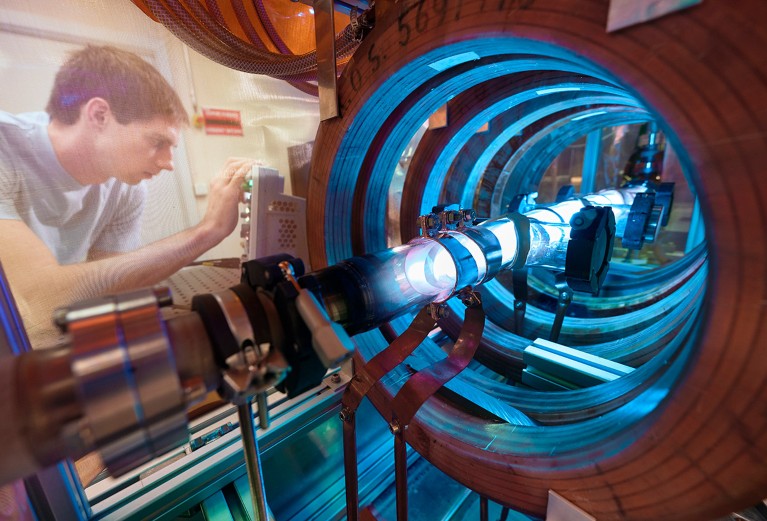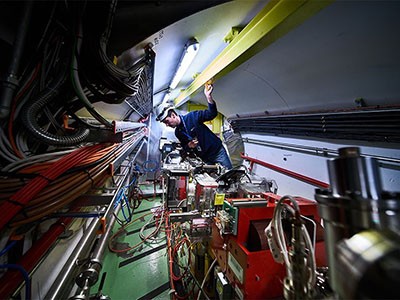
CERN’s mini-accelerator AWAKE was built to demonstrate plasma wakefield acceleration.Credit: Julien Marius Ordan/CERN/Science Photo Library
Physicists are sketching the designs of a particle accelerator that would be radically smaller and cheaper than existing facilities. The technique behind these designs, known as wakefield acceleration, has been studied since the 1970s but is now making rapid advances.
CERN’s pioneering mini-accelerator passes first test
Physicists use accelerators to study particles in intense detail, and, they hope, to discover new ones. Now that scientists are thrashing out plans for the next flagship particle colliders — to follow on from the Large Hadron Collider (LHC) at CERN, Europe’s particle-physics laboratory near Geneva, Switzerland — wakefield researchers are making their case to be involved. “Now is where the rubber meets the road,” says Spencer Gessner, a particle physicist at the SLAC National Accelerator Laboratory in Menlo Park, California, and part of the group working on a design for a wakefield accelerator.
“We need to make that transition from interesting science to building accelerators,” says Patric Muggli, an accelerator physicist at the Max Planck Institute for Physics in Munich, Germany.
Wakefield acceleration involves electrons surfing on a wave of plasma — an ionized gas — that is created either with another particle beam or with a laser. Conventional accelerator cavities — such as those at the LHC, which use electromagnetic fields to propel particles — are prone to sparking at high field strengths. But plasma-filled modules can withstand extreme fields. This means that over centimetre distances, wakefield technology can achieve an acceleration 1,000 times greater than conventional techniques can. If applied at scale, that could shrink an accelerator from kilometres to metres.
Collider design
Among the major hurdles for wakefield accelerators will be stitching together multiple chambers to boost particles to collider energies, and creating uniform and identical beams. Other challenges will be mastering how to accelerate positrons — the harder-to-handle antimatter counterparts of electrons — and deciding which kind of wakefield accelerator to pitch. “We have to make up our own mind,” says Muggli.
Over the next four years, the researchers plan to work on technical challenges and to select a single, most promising, method as the basis of a demonstrator machine ten years from now, says Gessner. “Our goal is to make something very concrete.”
The biggest machine in science: inside the fight to build the next giant particle collider
Wakefield acceleration “could make our footprint way smaller, which is cheaper, and it also seems incredibly flexible and scalable”, says Nicole Hartman, an experimental particle physicist at the Technical University of Munich in Germany. “If I were a billionaire, this is 100% what I would fund.”
Wakefield technology is not mature enough to be used in the world’s next collider, a ‘Higgs factory’ that would smash together electrons and positrons in precision studies, and be the successor to the LHC.




